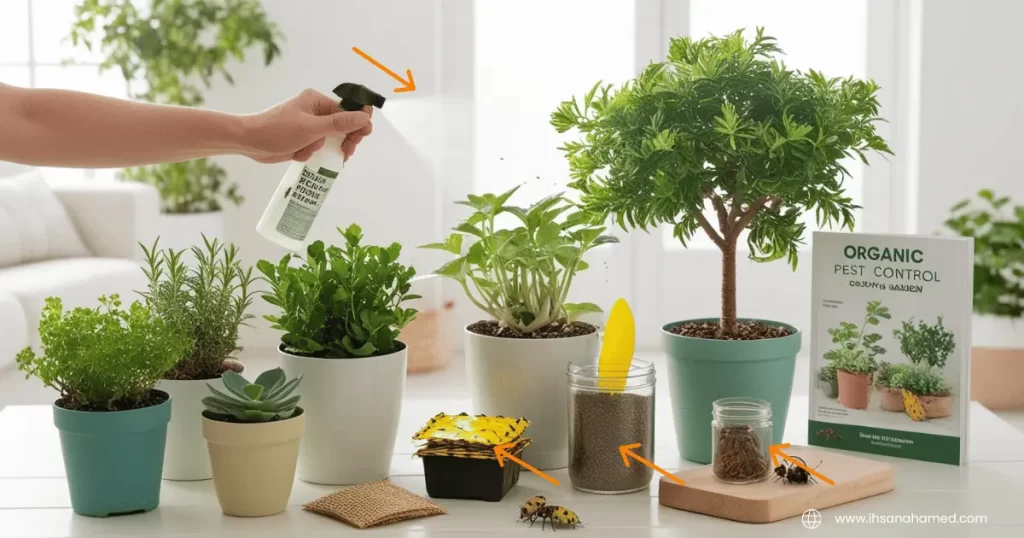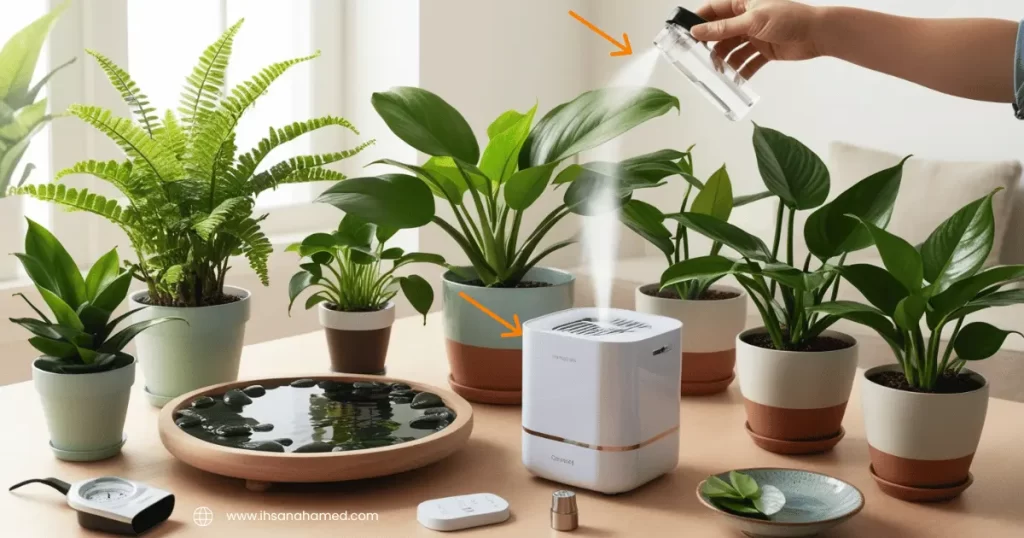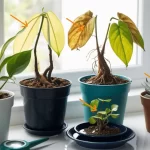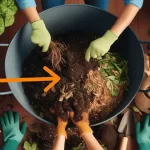1. Conquering Soil Woes for Indoor container gardening problems

Starting your container gardening requires more attention to soil-related challenges. Here I will explain how to overcome this situation.
Identifying and Fixing Soil Drainage Issues
Proper drainage is crucial for plant health. If the water is not drained properly, it will create problems, that may impact plant growth. Your plant is trying to tell you something with the following symptoms.
Puddles in the pot: Water sitting on the soil surface without draining.
Moldy or slimy soil: It means too wet and gross and not good for plants.
Droopy plants even when the soil is wet: It means water is required properly but it gets stuck in the soil and doesn’t reach the root.
To fix drainage problems, consider the following solutions
- Add perlite or vermiculite – These materials improve aeration and help water flow through the soil more efficiently.
- Use pots with drainage holes – Make sure the container has proper drainage holes for water to flow for excess water.
Maintaining Optimal Soil pH and Nutrient Balance
The right pH level maintains the nutrient levels for your plants. Most houseplants need to be maintained between slightly acidic to neutral soil (pH 6.0 to 7.0).
Regularly check soil using the best pH meter or testing kit with high quality.

Once you determine your soil pH, take corrective action by
- Adding lime – Increases alkalinity if needed.
- Incorporating sulfur – Lowers pH levels for those needing more acidity.
Preventing Soil Compaction in Confined Containers
Efficient water absorption is to be maintained properly for healthy roots to impact soil compaction.
Don’t make the soil particles tighten because it creates a major problem for the layer roots to penetrate.
This will stunt the plant’s development and make it difficult for plants to access the moisture.

To prevent this, remember to
- Aerate your soil regularly – Gently poke holes in the surface when watering.
- Use a light, well-aerated potting mix – opt for blends specifically designed for container gardening.
By addressing these common and unique problems. you will cultivate a healthy indoor garden that flourishes throughout the year.
2. Mastering the Art of Indoor Plant Watering

The next biggest headache for indoor gardeners is to understand watering needs for indoor container vegetables and plants.
Because all the plants are not watered equally, you need to look carefully at the unique watering methodology for every plant by species, size, and environment.
Determining the Right Watering Frequency
Determining the right watering frequency for your plants can feel like a daunting task. Several factors look into consideration for plant types, soil composition, and environmental conditions.
- Research Plant Needs – Familiarize yourself with the specific moisture preferences of your plants.
- Consider Conditions – Factors like light levels, humidity, and temperature can also affect how often you should water.
Establish a routine by checking soil moisture before watering. Stick your finger into the soil about an inch down, if it feels dry, it’s time for plants to drink.
Spotting Signs of Over- and Under-Watering
To maintain a healthy balance, it’s important to assess your watering routine regularly. Checking the moisture level in the soil can help you determine when to water again. By observing these signs closely, you can maintain your plants that will flourish.
Understanding the signs of over- and under-watering your plants is essential for plant growth.
Over-Watering Symptom
- Yellowing leaves
- Root rot or mushy roots
- Mold on the surface of the soil
Under-Watering Symptoms
- Brown leaf tips
- Wilting leaves
- Soil pulling away from the pot edges
To ensure your plants thrive
- Use Quality Planters – Ensure pots have drainage holes to prevent water accumulation.
- Adjust Watering Techniques -Consider using self-watering pots or moisture meters for more accurate assessments.
- Create a Schedule – Develop a consistent watering schedule based on seasonal changes and plant growth phases.
By understanding these techniques, you will have optimal care for your indoor garden.
3. Ensuring Adequate Lighting for Indoor Container Plants

Providing adequate light is necessary for plant health and growth for indoor container gardening problems for plants. Every plant has its own lighting requirements and it varies from plant to plant.
Understanding the Light Requirements of Various Indoor Plants
Understanding the lighting requirements for each plant, some may require bright or direct sunlight, medium lights, and lowlights.
Here’s a quick breakdown
- High-light plants – Succulents, cacti, and certain herbs.
- Medium-light plants – Spider plants, pothos, and peace lilies.
- Low-light plants -Snake plant, ZZ plant, and ferns.
Getting to know your plants’ needs will set you on the path to successful indoor gardening.
Choosing the Best Artificial Lighting Solutions
If your home is lacking natural sunlight or low sunlight or during darker months. Use artificial solutions for your plants.

Consider these options
- LED grow lights -Energy-efficient and long-lasting; they simulate sunlight.
- Fluorescent lights – Affordable and suitable for a range of plant types.
- Incandescent bulbs – Less efficient but a good choice for specific situations.
By selecting the appropriate lighting solution based on your plant’s requirements, you’ll promote growth effectively.
Maximizing Natural Light Exposure in Your Indoor Garden
Even Though your home lacks natural light, you can fulfill the plant’s needs if you place it in the right place. South-facing windows generally provide adequate lights for your plants and keep in mind and make sure it is enough for your plants.

consider a few creative methods
- Position pots near windows that receive sunlight throughout the day.
- Use sheer curtains to diffuse harsh sunlight while still allowing brightness in.
- Rotate containers regularly to ensure even light distribution on all sides of each plant.
These strategies not only improve growth rates but also contribute to a more beautiful living space. Embracing proper lighting techniques is key to nurturing thriving indoor gardens.
4. Tackling Pest Infestations in Indoor Containers

Indoor gardening is fun with happiness and joy. It also has another face of risk in pest infestations. Understand how to maintain plant care from these pests.
Identifying Common Indoor Garden Pests
Indoor gardening brings more happiness and enjoyment to your home. One of the most common critical issues faced by indoor gardeners is facing a pest. Understand and recognize these pests from serious damage to save your plants.
Common offenders include
- Aphids – Small, green insects that cluster on new growth.
- Spider Mites – Tiny, spider-like creatures that create fine webbing on leaves.
- Whiteflies – Small white insects that fly up when you disturb affected plants.
Monitoring your plants regularly will help catch these pests early before they cause significant damage.
Implementing Organic Pest Control Measures
From my personal experience organic pest control is a better choice to manage these pests rather than synthetic chemicals.. These techniques not only protect your plants but also support a healthier ecosystem.

- Neem Oil – A natural insecticide that disrupts pest life cycles.
- Insecticidal Soap – Targets soft-bodied insects without harming beneficial species.
- Diatomaceous Earth – A powder made from fossilized algae, it can deter crawling insects by damaging their exoskeletons.
These solutions are effective while remaining safe for both your plants and the environment.
Preventing Future Pest Problems Through Good Practices
One of the best strategies to keep pests away from plants is to maintain cleanliness in your living areas. Regular sweeping and vacuuming your home to prevent food particles from welcoming your plant enemy.
- Regular Inspections – Routinely check your plants for any signs of pests or disease.
- Proper Watering and Drainage – Over-watering can create conditions conducive to pests like fungus gnats.
- Sanitizing Tools and Containers – Keep all gardening tools clean to avoid transferring pests between plants.
By maintaining these habits, you will develop a habit of cleanliness in your home as well as free from pests for your indoor garden.
5. Maintaining the Ideal Temperature and Humidity for Indoor Plants

Maintaining an ideal climate is essential for your plant growth. Each plant has its own unique temperature and humidity to impact a plant’s health, act accordingly.
Addressing Temperature Fluctuations and Extremes
Temperature fluctuations and extremes can have a significant impact on our daily lives, from how we dress to how we operate our homes. Understanding these variations is crucial for maintaining comfort and ensuring safety.
- Avoid Drafts – Keep plants away from windows or doors where cold drafts can occur.
- Monitor Heat Sources – Be cautious of placing plants near heaters or radiators, as extreme heat can damage delicate foliage.
Sudden climate changes result in wilt or drop leaves. Use a high-quality thermometer to maintain a temperature in your living space.
Boosting Humidity Levels for Sensitive Indoor Plants
Humidity is often forgettable but it plays an important role in maintaining a moisture level in your environment for your tropical plants.

- Use Humidifiers – Invest in the best high-quality humidifier to maintain moisture levels in the air.
- Group Your Plants – Keeping plants close together creates a microenvironment with increased humidity.
Plants such as ferns and orchids need more moisture levels in the air and spray them often to make them happy like a little shower.
You can add a few stones or rocks in wet conditions over the tray on the pot. When the water dries, it helps the moisture level in the air and it creates a mini-environment that feels natural and helps them to grow better.
6. Optimizing Nutrition and Fertilization for Thriving Indoor Containers

Each plant needs its unique food mix in its pots and understands the tastes of each plant to stay healthy and bigger. When you give the right food, they will grow better than you imagine.
Recognizing Nutrient Deficiencies in Indoor Plants
If you don’t provide the right food or insufficient food that may result in hunger for plants which leads to yellow leaves, slow growth, weak stems, and fewer flowers than usual. Even people who grow plants for a longer time can be confused due to these signs.
When the plants do not have enough nutrients they are sick and unhappy, understand and recognize these spots and signs to keep your plants healthy and looking good.
Nutrient deficiencies can manifest in various ways
- Yellowing leaves may indicate nitrogen deficiency.
- Brown edges on leaves often signal potassium shortage.
- Stunted growth could result from insufficient phosphorus.
Keep an eye on your plants regularly to address these signs. Look for any weird changes, act immediately, and fix them before they make an impact on our plants.
Choosing the Right Fertilizers and Feeding Schedule
Choosing the right fertilizers and creating an effective feeding schedule is essential for healthy plant growth. Not all plants have the same nutrient requirements, so understanding what your specific plants need is crucial.

Selecting the appropriate fertilizer is crucial for plant health. Consider
Type of Plant – Different species have varying nutrient requirements.
Fertilizer Composition – Look for N-P-K ratios that match your plant’s needs.
Bloom booster – This is a special food for flowering plants.
Cactus and succulent food – This is a special mix for plants that don’t need more water.
A general rule of thumb is to fertilize every 4–6 weeks during the growing season, feed them less, or stop feeding. Most indoor plants need sleep during winter and some plants need different feeding schedules but it works for most indoor plants.
7. Avoiding Common Fertilization Mistakes

Fertilizers are just like superfoods, it makes them grow bigger and stronger. But eating a lot of junk food can harm you, the same way feeding too much fertilizer can cause big problems for your plants.
Don’t feed them much, it can make them sick and even lead to death.
Recommending you read the manuals before use, it will teach you how much to use and it’s like following a recipe.
Common feeding problems and how to avoid them
Just like humans, indoor plants require proper food to survive, common mistakes in feeding lead to various issues such as plants failing to grow at normal rates to yellow leaves.
Over Fertilizing
- Problem: Too much fertilizer can damage your plant roots and lead making your leaf tips brown and crisp.
- Solution: Follow the instructions in the fertilizer manual before using, always start with half the quantity recommended and increase it slowly based on the plant’s needs
Under Fertilizing
- Problem: Insufficient nutrients can bring slow growth, pale leaves, and weaker stems
- Solution: Fertilize your plants during growing seasons like spring and summer.
Incorrect Fertilizer Type
- Problem: Using fertilization based on plant needs may lead to nutrient imbalance
- Solution: Research the specific needs of your plant and choose a fertilizer accordingly. For example, African violets require a low-nitrogen fertilizer.
Fertilizing on Wrong Time
- Problem: Fertilize your plants when necessary or else it may harm your plants
- Solution: Avoid fertilizing during winter because it’s recovering from diseases and pets.
Ignoring Soil Quality
- Problem: Avoid poor quality. It may be hard for plants to get nutrients. It’s just like a healthy meal feeding with a broken spoon.
- Solution: Choose the best and highest-quality potting mix specifically designed for indoor plants. Report your plants regularly to refresh the soil.
Neglecting Water Quality
- Problem: Tap water has a high amount of minerals it can absorb over time on the soil, and it is difficult for plants to eat.
- Solution: Use filtered water or let tap water sit for a day before using it to water your plants.
Remember
- Observe your plants closely: plant appearance can tell you about their health; it may cause changes in leaf color, growing slowly and unhealthy. It means plants are not getting enough nutrients.
- Less is often more. You need to under-fertilize your plants to recover from over-fertilization.
By following these guidelines, you can create an optimal environment that nurtures vibrant and healthy indoor plants.
Conclusion
Indoor container gardening problems come with rewards and hobbies but it comes with unique challenges from pests to poor lighting and common indoor container problems that are crucial for success.
By familiarizing yourself with expert solutions and slowly learning what works best for your space.
Are you looking to master an indoor garden? Explore our few helpful guides on learning how to water the indoor container vegetables, indoor vegetable container combos, and the best quality soil mix for your veggies.
Remember that every plant has its unique needs, so don’t hesitate to adjust your approach based on plant needs.
What are the common signs of over-watering plants in containers?

Overwatered plants often exhibit yellowing leaves, wilting, and root rot. The soil may feel soggy or have a foul odor.
How can I prevent pests from infesting my indoor container plants?

To deter pests, maintain cleanliness around your plants, use neem oil or insecticidal soap, and regularly check for signs of infestation.
Why are my indoor plant leaves turning brown at the tips?

Brown tips can result from under-watering, low humidity levels, or excessive fertilizer application. Assess your watering routine and environmental conditions.
How often should I fertilize my indoor container plants?

Most indoor plants benefit from fertilization every 4-6 weeks during the growing season (spring and summer). Always follow specific guidelines for each type of plant
Can I reuse potting soil for my indoor container gardening?

Yes, but it’s essential to refresh reused soil by mixing it with a new potting mix and adding nutrients to avoid nutrient depletion and disease buildup.







